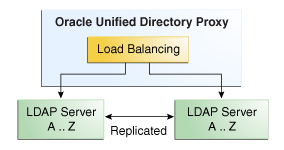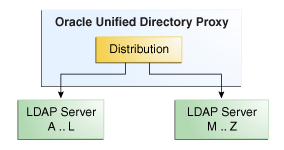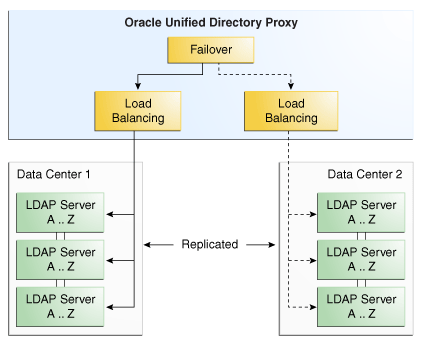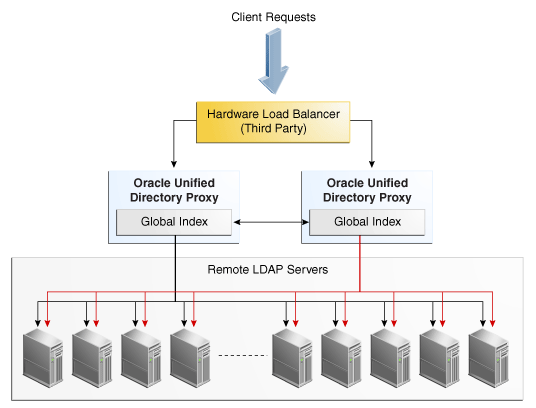3 Example Deployments Using the Proxy Server
There are many types of deployment in which the Oracle Unified Directory proxy can be used successfully. The following are suggested deployments, which will help familiarize you with how the proxy works.
This chapter covers the following topics:
-
Section 3.4, "Configuration 3: Failover Between Data Centers"
-
Section 3.5, "Configuration 4: Distribution with Load Balancing"
-
Section 3.6, "Configuration 5: Distribution with Failover Between Data Centers"
3.1 Deciding Your Proxy Deployment Type
There are two main types of deployment with the proxy, namely load balancing and distribution.
To decide which type of deployment you want, consider this: where and how is your data stored and how much data do you handle?
-
If all your data is stored on a replicated data store, then use a deployment with load balancing. See Configuration 1: Simple Load Balancing.
-
If your data is partitioned or you have a large database and want to split your data so that it is partitioned on different data sources, then use a deployment with distribution. See Section 3.3, "Configuration 2: Simple Distribution."
More complex deployment scenarios can be defined, which layer load balancing and distribution. The main question will be, do you need load balancing, or distribution, or both?
Other than simple load balancing and simple distribution, the following example deployments will be presented:
-
If you want to deploy data centers in different geographical locations, for example, you could deploy failover between two load-balanced data centers. See Section 3.4, "Configuration 3: Failover Between Data Centers."
-
If you want to use distribution but want the data partitions to be replicated, you can deploy the proxy server using distribution which routes to load balancer. See Section 3.5, "Configuration 4: Distribution with Load Balancing."
-
If you want to use distribution with the data partitions replicated, but for availability and disaster recover you want the partitions to not only be replicated in one data center but also want to replicate the data centers in two different geographical locations, then you could deploy an architecture similar to Section 3.6, "Configuration 5: Distribution with Failover Between Data Centers."
You can add a global index catalog to deployments using distribution, to map entries to a specific partition. This will help minimize the use of broadcasts. For information on configuring a global index catalog, see Section 15.1.7, "Configuring Global Indexes By Using the Command Line."
3.2 Configuration 1: Simple Load Balancing
When you deploy the proxy for load balancing, all requests that the proxy receives are routed to one of the remote LDAP servers. As illustrated in Figure 3-1, the remote LDAP servers are replicated and contain the same data. The number of supported remote LDAP servers is not limited.
The requests are routed to one of the remote LDAP servers based on the load balancing algorithm set during deployment.
The load balancing algorithms are:
-
failover -
generic -
optimal -
proportional -
saturation -
searchfilter
For more information on the different load balancing algorithms, see Section 11.1, "Load Balancing Using the Proxy."
The algorithm can be bypassed by a client connection affinity. If you set client connection affinity, the proxy uses the load balancing algorithm for the first request, but for the following request will disregard the load balancing algorithm set and will try to reuse the same route for a new operation on the same client connection, for example, depending on the type of client affinity set. For more information, see Section 15.1.3.5.7, "Setting Client Connection Affinity."
The advantages of using load balancing deployment are the high availability of the data, as well as an adapted workload on the remote LDAP servers. For example, if one of the remote LDAP servers in your configuration becomes unavailable, the load balancing will route the request to another remote LDAP server. In this case, the failure is not visible to the client and there is no service disruption.
A simple load balancing deployment can be configured easily during the proxy installation.
3.3 Configuration 2: Simple Distribution
When you deploy the proxy for simple distribution, the data is split into partitions. Each partition of data is held on a separate remote LDAP server, as illustrated in Figure 3-2. Here, LDAP Server A...L is a server that holds entries for users whose names start with A through L. Similarly, LDAP Server M…Z holds entries for users whose names start with M through Z. All requests that the proxy receives are routed to the remote LDAP server which contains the appropriate data.
The number of remote LDAP servers onto which the data is partitioned depends on the size of the database that you are splitting. Figure 3-2 shows simple distribution algorithm with two partitions, but you can configure more.
The requests are routed to one of the remote LDAP servers based on the distribution algorithm set during deployment.
The distribution algorithms are:
-
capacity -
numeric -
lexico -
dnpattern
For more information on the different distribution algorithms, see Section 11.2, "Data Distribution Using the Proxy."
The advantage of a deployment using distribution is that you can scale the number of updates per second. To diminish the number of broadcasts when using distribution, you can add a global index catalog. For information about the global index catalog, see Section 15.1.7, "Configuring Global Indexes By Using the Command Line."
A simple distribution deployment can be easily configured during the proxy installation.
3.4 Configuration 3: Failover Between Data Centers
When you configure failover between data centers, you are essentially deploying two levels of load balancers within the proxy. In this deployment, the data centers are replicated and the remote LDAP servers within the data centers are also replicated. The first load balancing element of the deployment can be either failover or saturation. The example assumes failover algorithm is selected for the initial load balancing element.
As illustrated in Figure 3-3, all of the requests are routed by the failover load balancer through the main route, to a second load balancing element, which sends the request to a server within Data Center 1. Here, LDAP Server A...L is a server that holds entries for users whose names start with A through L. If Data Center 1 goes down or is degraded, then the traffic is routed by the failover load balancer to the backup route, to a server in Data Center 2.
The requests are routed to the remote LDAP servers within the data centers based on the load balancing algorithm set. The load balancing algorithm can be different for each data center. For example, you can set the load balancing in Data Center 1 as proportional, while the load balancing algorithm in Data Center 2 is set as saturation.
This type of deployment is typically used when deploying in two geographical areas. This adds high availability of data to a simple load balancing deployment, since not only are the remote LDAP servers replicated, but the data centers are also replicated.
Typically, you would have the two data centers in two different geographical locations. This way, if there was a problem in one location, the data center in the other location would act as backup. Another example would be setting the first load balancer to saturation. This way, if Data Center 1 in one geographical location (for example in one time-zone) becomes saturated, the other data center can pick up the excess traffic.
For more information on the different load balancing algorithms, see Load Balancing Using the Proxy.
For details on deploying this configuration, see Failover Load Balancing.
3.5 Configuration 4: Distribution with Load Balancing
In a deployment that includes distribution and load balancing, the data is split into partitions, and the data is replicated on the remote LDAP servers. Requests sent to the proxy are first distributed to the partition in which the data is stored, then the request is routed to one of the remote LDAP servers, depending on the load balancing algorithm set. The remote LDAP servers holding the partitioned data are replicated.
As illustrated in Figure 3-4, when the proxy receives a requests, it is filtered by the distribution to the correct partition. Here, LDAP Server A...L is a server that holds entries for users whose names start with A through L. Similarly, LDAP Server M…Z holds entries for users whose names start with M through Z. For example, a request for entry with a cn such as Garry would be forwarded to partition 1, to the servers with data from A..L. The load balancer then forwards the request to one of the replicated remote LDAP servers.
Figure 3-4 Distribution with Load Balancing

Description of "Figure 3-4 Distribution with Load Balancing"
The requests are routed to the remote LDAP servers within the data centers based on the load balancing algorithm set. For more information on the different load balancing algorithms, see Section 11.1, "Load Balancing Using the Proxy."
The advantages of this deployment are the speed of the updates, because of the distribution of data, and high availability of the data.
For more information on the different distribution algorithms, see Section 11.2, "Data Distribution Using the Proxy."
For more information on the different load balancing algorithms, see Section 11.1, "Load Balancing Using the Proxy."
For details on deploying this configuration, see Chapter 11, "Understanding the Proxy Functionality."
3.6 Configuration 5: Distribution with Failover Between Data Centers
In a deployment that includes distribution with failover load balancing between two data centers, the data is split into partitions, where each partition is managed through a failover load balancing route. As illustrated in Figure 3-5, not only are the remote LDAP servers holding the partitioned data replicated within the data center, but in addition, the data centers are replicated, with one of the two acting as the backup. Here, LDAP Server A...L is a server that holds entries for users whose names start with A through L. Similarly, LDAP Server M…Z holds entries for users whose names start with M through Z.
Figure 3-5 Distribution with Failover Between Data Centers
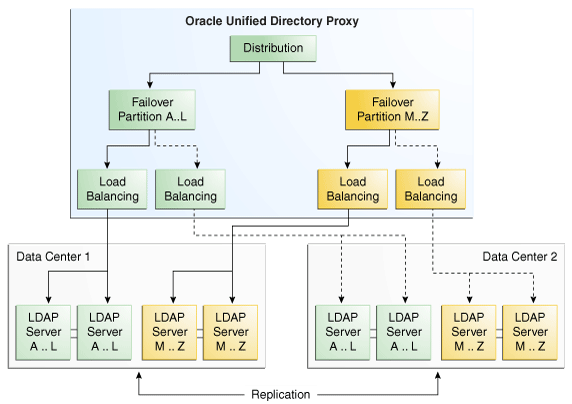
Description of "Figure 3-5 Distribution with Failover Between Data Centers"
In other words, requests sent to the proxy are first distributed to the partition in which the data is stored. For example, a request for entry with a cn such as Garry would be forwarded to partition 1. The failover load balancer then forwards the request through the main route, depending on the load balancing algorithm set, to one of the one of the remote LDAP servers holding the data for A..L.
In the deployment illustrated in Figure 3-5, Data Center 2 acts as a backup, and is only used on failure of the first data center. However, this same deployment could be configured to use saturation, rather than a failover load balancer. This way, if Data Center 1 in one geographical location (for example in one time-zone) becomes saturated, the other data center can pick up the excess traffic.
The advantages of this deployment are the speed of the reads through the distribution algorithm, and the high availability offered since the remote LDAP servers are replicated, and one data center acts as a backup.
For more information on the different distribution algorithms, see Section 11.2, "Data Distribution Using the Proxy."
For more information on the different load balancing algorithms, see Section 11.1, "Load Balancing Using the Proxy."
For details on deploying this configuration, see Section 16.5, "Configuring Distribution with Failover Between Data Centers."
3.7 Configuration 6: Enterprise User Security
When you deploy the proxy for Enterprise User Security (EUS), the configuration details are stored locally in Oracle Unified Directory and the remote external LDAP directory contains only the Enterprise Users and the Enterprise Groups details.
As illustrated in Figure 3-6 the remote external LDAP directory contains only the Enterprise Users and the Enterprise Groups details.
Figure 3-6 Proxy Enterprise User Security
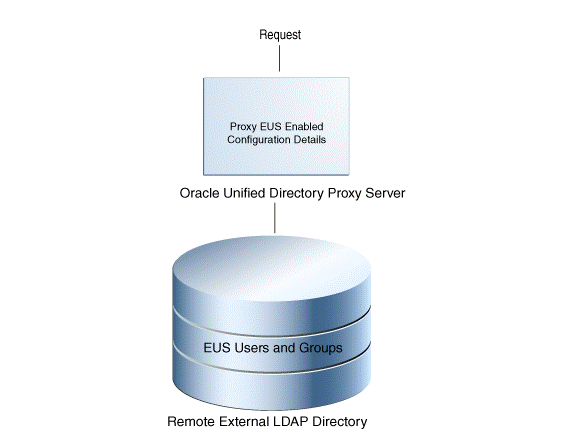
Description of "Figure 3-6 Proxy Enterprise User Security"
The requests are routed to one of the remote LDAP servers based on the load balancing algorithm set during deployment.
The load balancing algorithms are:
-
failover -
optimal -
proportional -
saturation
For more information on the different load balancing algorithms, see Section 11.1, "Load Balancing Using the Proxy."
To configure this proxy deployment complete the following steps:
-
Setup the proxy server, as described in the "To Configure Enterprise User Security" section in the Oracle Fusion Middleware Installation Guide for Oracle Unified Directory.
-
Integrate Oracle Unified Directory and Enterprise User Security, as described in Chapter 25, "Integrating With Oracle's Enterprise User Security".
3.8 Multiple Replicated Proxies
To prevent a Single Point of Failure, you should ensure that your deployment is redundant. Typically, this can be done by installing a third party hardware load balancer, as illustrated in Figure 3-7.
Using a hardware load balancer, you can manage multiple proxy instances on separate physical machines or in different geographical locations.
When running multiple proxy instances in a distribution deployment with a global index catalog, the global index catalog should be replicated. For more information on replicating the global index catalog, see Section 15.1.7.2, "Replication of Global Index Catalogs."
To configure this proxy deployment, see "Setting Up the Proxy Server" section in the Oracle Fusion Middleware Installation Guide for Oracle Unified Directory.
